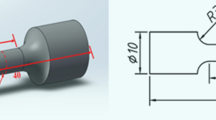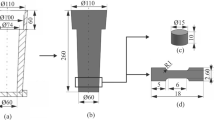Abstract
The influence of low concentrations (1 mol %) of co-dopants (Y, Ce, Gd, Er, La, Zn, Mn, Co and Cu) on the microhardness and fracture toughness of Zr0.81Sc0.19O2–δ (10.5ScSZ) solid electrolyte was studied by the indentation method. It was shown that co-doping of 10.5ScSZ by the rare-earth elements (Y, Ce, Gd, Er) results in microhardness increase on 4–45% due to stabilization of cubic phase in the grains, while the microhardness changing upon transition metals (Mn, Cu, Co, Zn) introduction is caused by the grain boundaries modification. The microhardness decreases on ~4 and 10% upon doping by Mn and Cu, accordingly, whereas the introduction of Co and Zn results in its increase approximately by 2 times. It was shown also that the influence of all investigated dopants on the fracture toughness is insignificant. The maximal effect observed for Cu was the fracture toughness increase from 2.1 up to 2.6 MPa m0.5.
Similar content being viewed by others
References
Fergus, J.W., Electrolytes for solid oxide fuel cells, J. Power Sources, 2006, vol. 162, pp. 30–40.
Badwal, S.P.S., Ciacchi, F.T., and Milosevic, D., Scandia–zirconia electrolytes for intermediate temperature solid oxide fuel cell operation, Solid State Ionics, 2000, vols. 136–137, pp. 91–99.
Lee, D.-S., Kim, W.S., Choi, S.H., et al., Characterization of ZrO2 co-doped with Sc2O3 and CeO2 electrolyte for the application of intermediate temperature SOFCs, Solid State Ionics, 2005, vol. 176, pp. 33–39.
Kondoh, J., Tomii, Y., and Kawachi, K., Changes in aging behavior and defect structure of yttria-fully-stabilized ZrO2 with Sc2O3 doping, J. Am. Ceram. Soc., 2003, vol. 86, pp. 2093–2102.
Spirin, A., Ivanov, V., Nikonov, A., Lipilin, A., et al., Scandia-stabilized zirconia doped with yttria: synthesis, properties, and ageing behavior, Solid State Ionics, 2012, vol. 225, pp. 448–452.
Abbas, H.A., Argirusis, C., Kilo, M., Wiemhofer, H.D., et al., Preparation and conductivity of ternary scandiastabilised zirconia, Solid State Ionics, 2011, vol. 184, pp. 6–9.
Omar, S., Najib, W.B., Chen, W., and Bonanos, N., Electrical conductivity of 10 mol% Sc2O3–1 mol % M2O3–ZrO2 ceramics, J. Am. Ceram. Soc., 2012, vol. 95, pp. 1965–1972.
Nikonov, A.V., Khrustov, V.R., Bokov, A.A., Koleukh, D.S., and Zayats, S.V., Co-doping effect on the properties of scandia-stabilized ZrO2, Russ. J. Electrochem., 2014, vol. 50, no. 7, pp. 625–629.
Guo, C.X., Wang, J.X., He, C.R., and Wang, W.G., Effect of alumina on the properties of ceria and scandia co-doped zirconia for electrolyte-supported SOFC, Ceram. Int., 2013, vol. 39, pp. 9575–9582.
Orlovskaya, N., Lukich, S., Subhash, G., Graule, T., and Kuebler, J., Mechanical properties of 10 mol % Sc2O3–1 mol % CeO2–89 mol % ZrO2 ceramics, J. Power Sources, 2010, vol. 195, pp. 2774–2781.
Osipov, V.V., Kotov, Yu.A., Ivanov, M.G., Samatov, O.M., et al., Laser synthesis of nanopowders, Laser Phys., 2006, vol. 16, pp. 116–125.
Nicholas, J.D. and De Jonghe, L.C., Prediction and evaluation of sintering aids for cerium gadolinium oxide, Solid State Ionics, 2007, vol. 178, pp. 1187–1194.
Flegler, A.J., Burye, T.E., Yang, Q., and Nicholas, J.D., Cubic yttria stabilized zirconia sintering additive impacts: a comparative study, Ceram. Int., 2014, vol. 40, pp. 16323–16335.
Nikonov, A.V., Spirin, A.V., Khrustov, V.R., Paranin, S.N., et al., Synthesis and properties of solid electrolyte Ce0.9Gd0.1O2–δ with Co, Cu, Mn, Zn doping, Inorg. Mater., 2016, vol. 52, no. 7, pp. 708–715.
Lei, Z. and Zhu, Q., Low temperature processing of dense nanocrystalline scandia-doped zirconia (ScSZ) ceramics, Solid State Ionics, 2005, vol. 176, pp. 2791–2797.
Sheu, T.-S., Xu, J., and Tien, T.Y., Phase relationships in the ZrO2–Sc2O3 and ZrO2–In2O3 systems, J. Am. Ceram. Soc., 1993, vol. 76, pp. 2027–2032.
Yuan, F., Wang, J., Miao, H., Guo, C., and Wang, W.G., Investigation of the crystal structure and ionic conductivity in the ternary system (Yb2O3)x–(Sc2O3)(0.11–x)–(ZrO2)0.89 (x = 0–0.11), J. Alloys Compd., 2013, vol. 549, pp. 200–205.
Kawada, T., Sakai, N., Yokokawa, H., and Dokiya, M., Electrical properties of transition-metal-doped YSZ, Solid State Ionics, 1992, vols. 53–56, pp. 418–425.
Hartmanova, M., Poulsen, F.W., Hanic, F., et al., Influence of copper-and iron-doping on cubic yttriastabilized zirconia, J. Mater. Sci., 1994, vol. 29, pp. 2152–2158.
Seidensticker, J.R. and Mayo, M.J., Thermal analysis of 3-mol %-yttria-stabilized tetragonal zirconia powder doped with copper oxide, J. Am. Ceram. Soc., 1996, vol. 79, pp. 401–406.
Laguna-Bercero, M.A., Larrea, A., Pena, J.I., Merino, R.I., and Orera, V.M., Structured porous Ni-and Co-YSZ cermets fabricated from directionally solidified eutectic composites, J. Eur. Ceram. Soc., 2005, vol. 25, pp. 1455–1462.
Silva, G.C.T. and Muccillo, E.N.S., Effect of Co addition on sintering and electrical properties of yttria-stabilized zirconia, Mater. Sci. Forum, 2008, vols. 591–593, pp. 397–401.
Pastor, M., Prasad, A., Biswas, K., Pandey, A.C., and Manna, I., Microstructural and impedance study of nanocrystalline lanthana-doped scandia-stabilized zirconia, J. Nanopart. Res., 2012, vol. 14, paper 1031.
Ran, S., Winnubst, L., Blank, D.H.A., Pasaribu, H.R., et al., Effect of microstructure on the tribological and mechanical properties of CuO-doped 3Y-TZP ceramics, J. Am. Ceram. Soc., 2007, vol. 90, pp. 2747–2752.
Aktas, B., Microstructure, mechanical and electrical properties of CuO doped 8YSZ, High Temp. Mater. Processes, 2013, vol. 32, pp. 551–556.
Samsonov G.V., Borisova A.L., Zhidkova T.G., Znatokova T.N., et al., Fiziko-khimicheskie svoistva okislov. Spravochnik (Physicochemical Properties of Oxides: A Handbook), Moscow: Metallurgiya, 1978.
Ramesh, S., Chew, W.J.K., Tan, C.Y., Purbolaksono, J., et al., Influence of manganese on the sintering properties of tetragonal zirconia, Ceram.–Silik., 2013, vol. 57, pp. 28–32.
Author information
Authors and Affiliations
Corresponding author
Additional information
The article was translated by the authors.
Original Russian Text © A.V. Nikonov, A.S. Kaygorodov, K.A. Kuterbekov, K.Zh. Bekmyrza, 2017, published in Neorganicheskie Materialy, 2017, Vol. 53, No. 9, pp. 957–962.
Rights and permissions
About this article
Cite this article
Nikonov, A.V., Kaygorodov, A.S., Kuterbekov, K.A. et al. Microhardness and fracture toughness of ZrO2–Sc2O3 solid electrolyte, doped with rare-earth and transition metals. Inorg Mater 53, 937–943 (2017). https://doi.org/10.1134/S002016851709014X
Received:
Published:
Issue Date:
DOI: https://doi.org/10.1134/S002016851709014X




